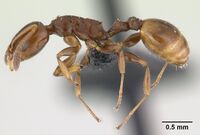Nesomyrmex madecassus
| Nesomyrmex madecassus | |
|---|---|

| |
| Scientific classification | |
| Kingdom: | Animalia |
| Phylum: | Arthropoda |
| Class: | Insecta |
| Order: | Hymenoptera |
| Family: | Formicidae |
| Subfamily: | Myrmicinae |
| Tribe: | Crematogastrini |
| Genus: | Nesomyrmex |
| Species group: | madecassus |
| Species: | N. madecassus |
| Binomial name | |
| Nesomyrmex madecassus (Forel, 1892) | |
This species is known to occur in Madagascar’s rain forests at very high altitudes between 690 and 2150m, mean: 1538m. This species is known to forage in low vegetation, nests can often be found in dead twigs, or rarely in leaf litter (leaf mold, rotten wood), or in rotten tree stumps.
Identification
A member of the madecassus species-group.
Csősz & Fisher (2016) - Workers of this species differ from that of Nesomyrmex gibber by having no mesothoracic hump, and from Nesomyrmex flavus and Nesomyrmex nitidus by its dark brown color versus the light yellow hue of the two latter species.
The dark color in madecassus populations is dominant across the entire known distributional area, and comprises ~95% of the examined material. However, a rare, lighter-colored madecassus phenotype (ocher phenotype) was also found in a few localities. There is no evidence, other than color, that would support heterospecifity of these two discrete phenotypes of N. madecassus workers and no correlation was found between elevational cline and color. Only one mixed sample is known to include both ocher and dark phenotype. Ocher madecassus phenotypes are darker than the majority of N. flavus and N. nitidus workers and also differ from the latter species by having brown femora and a dark patch on the first gastral tergite.
Nesomyrmex madecassus workers (including ocher phenotypes) can be separated from those of N. flavus and N. nitidus using a ratio of postocular area to cephalic width including compound eyes (PoOC/CW). A more precise means to separate ocher madecassus phenotype from workers of N. flavus and N. nitidus may be necessary. In these cases, a discriminant D4 funtion provides a moderately time consuming classification tool yielding non-overlapping ranges between madecassus workers and that of flavus and nitidus.
Keys including this Species
Distribution
Latitudinal Distribution Pattern
Latitudinal Range: -12.51444° to -23.84083°.
| North Temperate |
North Subtropical |
Tropical | South Subtropical |
South Temperate |
- Source: AntMaps
Distribution based on Regional Taxon Lists
Afrotropical Region: Comoros.
Malagasy Region: Madagascar (type locality), Mayotte.
Distribution based on AntMaps
Distribution based on AntWeb specimens
Check data from AntWeb
Countries Occupied
| Number of countries occupied by this species based on AntWiki Regional Taxon Lists. In general, fewer countries occupied indicates a narrower range, while more countries indicates a more widespread species. |

|
Estimated Abundance
| Relative abundance based on number of AntMaps records per species (this species within the purple bar). Fewer records (to the left) indicates a less abundant/encountered species while more records (to the right) indicates more abundant/encountered species. |

|
Biology
Castes
Worker
Images from AntWeb
   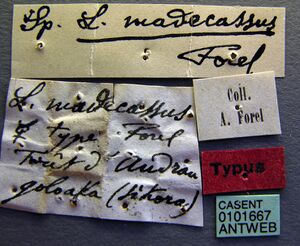
| |
| Syntype of Nesomyrmex madecassus. Worker. Specimen code casent0101667. Photographer Michele Esposito, uploaded by California Academy of Sciences. | Owned by MHNG, Geneva, Switzerland. |
  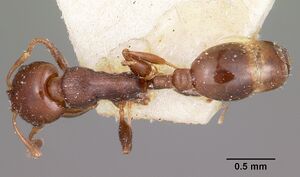 
| |
| Syntype of Nesomyrmex madecassus. Worker. Specimen code casent0101687. Photographer April Nobile, uploaded by California Academy of Sciences. | Owned by MHNG, Geneva, Switzerland. |
 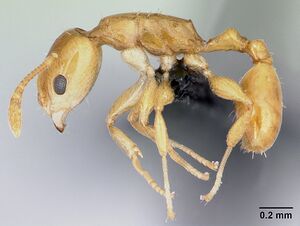  
| |
| Worker. Specimen code casent0132521. Photographer Erin Prado, uploaded by California Academy of Sciences. | Owned by CAS, San Francisco, CA, USA. |
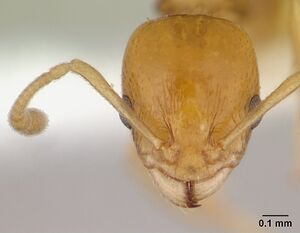 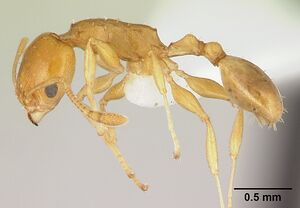  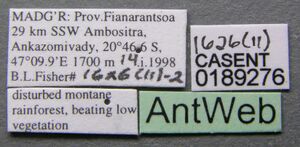
| |
| Worker. Specimen code casent0189276. Photographer Erin Prado, uploaded by California Academy of Sciences. | Owned by CAS, San Francisco, CA, USA. |
   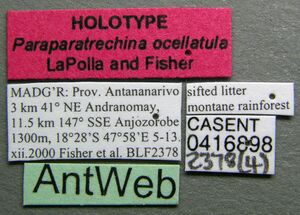
| |
| Holotype of Paraparatrechina ocellatula. Worker. Specimen code casent0416898. Photographer April Nobile, uploaded by California Academy of Sciences. | Owned by CAS, San Francisco, CA, USA. |
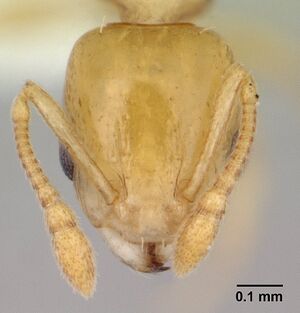 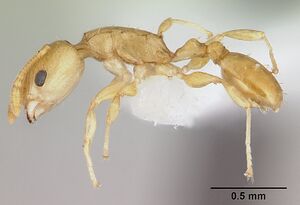  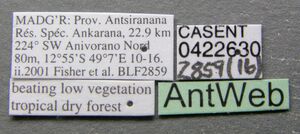
| |
| Worker. Specimen code casent0422630. Photographer Erin Prado, uploaded by California Academy of Sciences. | Owned by CAS, San Francisco, CA, USA. |
 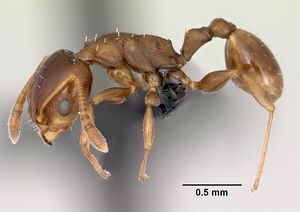  
| |
| Worker. Specimen code casent0487130. Photographer April Nobile, uploaded by California Academy of Sciences. | Owned by CAS, San Francisco, CA, USA. |
Queen
Images from AntWeb
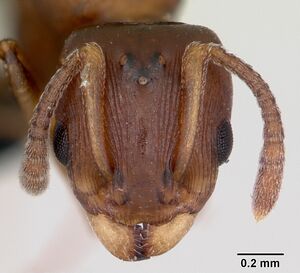 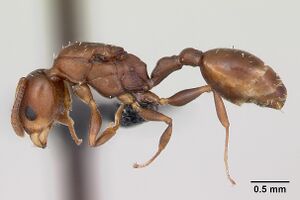  
| |
| Queen (alate/dealate). Specimen code casent0487131. Photographer April Nobile, uploaded by California Academy of Sciences. | Owned by CAS, San Francisco, CA, USA. |
   
| |
| Syntype of Nesomyrmex madecassus. Worker. Specimen code casent0102065. Photographer April Nobile, uploaded by California Academy of Sciences. | Owned by MSNG, Genoa, Italy. |
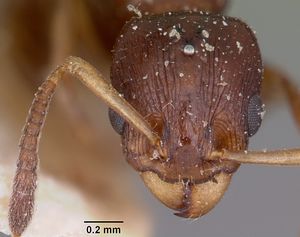 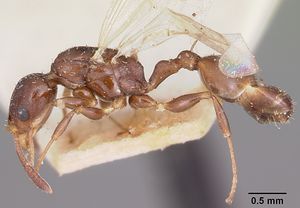 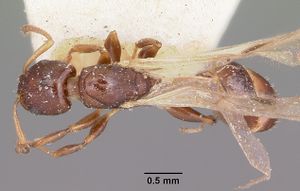 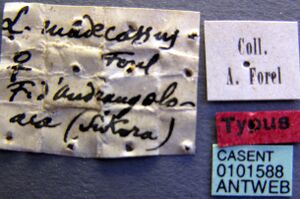
| |
| Queen (alate/dealate). Specimen code casent0101588. Photographer April Nobile, uploaded by California Academy of Sciences. | Owned by MHNG, Geneva, Switzerland. |
Male
Images from AntWeb
 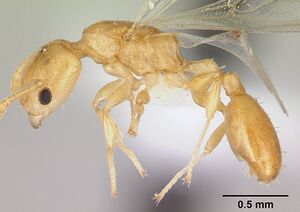 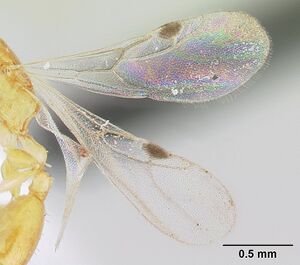  
| |
| Queen (alate/dealate). Specimen code casent0421406. Photographer Erin Prado, uploaded by California Academy of Sciences. | Owned by CAS, San Francisco, CA, USA. |
   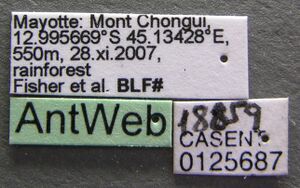
| |
| Queen (alate/dealate). Specimen code casent0125687. Photographer April Nobile, uploaded by California Academy of Sciences. | Owned by CAS, San Francisco, CA, USA. |
Nomenclature
The following information is derived from Barry Bolton's Online Catalogue of the Ants of the World.
- madecassus. Leptothorax madecassus Forel, 1892l: 265 (w.q.) MADAGASCAR.
- Combination in L. (Goniothorax): Emery, 1896g: 58 (footnote).
- Combination in Nesomyrmex: Bolton, 2003: 272.
- Status as species: Csősz & Fisher, 2016: 120.
Unless otherwise noted the text for the remainder of this section is reported from the publication that includes the original description.
Description
Worker
Csősz & Fisher (2016) - Body color: brown; black; rarely yellow. Body color pattern: Body concolorous. If yellow, body concolorous, clava, femora and 1st gastral tergite darker. Absolute cephalic size: 692 [616, 763]. Cephalic length vs. Maximum width of head capsule (CL/CWb): 1.18 [1.13, 1.22]. Postocular distance vs. cephalic length (PoOc/CL): 0.46 [0.43, 0.48]. Postocular sides of cranium contour frontal view orientation: converging posteriorly. Postocular sides of cranium contour frontal view shape: convex. Vertex contour line in frontal view shape: straight; slightly concave. Vertex sculpture: main sculpture inconspuous, ground sculpture smooth. Gena contour line in frontal view shape: convex. Genae contour from anterior view orientation: converging. Gena sculpture: rugoso-reticulate with feeble areolate ground sculpture. Concentric carinae laterally surrounding antennal foramen: present. Eye length vs. absolute cephalic size (EL/CS): 0.26 [0.24, 0.28]. Frontal carina distance vs. absolute cephalic size (FRS/CS): 0.31 [0.29, 0.33]. Longitudinal carinae on median region of frons: absent. Smooth median region on frons: present. Antennomere count: 12. Scape length vs. absolute cephalic size (SL/CS): 0.78 [0.72, 0.82]. Median clypeal notch: variable. Ground sculpture of submedian area of clypeus: present. Median carina of clypeus: absent. Lateral carinae of clypeus: present. Metanotal depression: variable. Dorsal region of mesosoma sculpture: areolate ground sculpture, superimposed by dispersed rugae. Lateral region of pronotum sculpture: areolate ground sculpture, main sculpture dispersed costate. Mesopleuron sculpture: ground sculpture areolate, main sculpture absent. Metapleuron sculpture: ground sculpture areolate, main sculpture absent. Petiole width vs. absolute cephalic size (PEW/CS): 0.22 [0.19, 0.24]. Anterior profile of petiolar node contour line in lateral view shape: concave. Dorso-caudal petiolar profile contour line in lateral view shape: convex. Dorsal region of petiole sculpture: ground sculpture areolate, main sculpture absent. Postpetiole width vs. absolute cephalic size (PPW/CS): 0.35 [0.29, 0.39]. Dorsal region of postpetiole sculpture: ground sculpture areolate, main sculpture absent.
Type Material
Csősz & Fisher (2016) - Syntype workers: CASENT0101667, (collection code: ANTC3246), CASENT0101687 (collection code: ANTC3247): [Madagascar, Prov.] Antsiranana, Forêt d’ Andrangoloaka [Antananarivo, -18.91 N, 47.55 E], Madagascar (Sikora)”, (CASENT0101667, CASENT0101687, Musee d'Histoire Naturelle Genève).
References
- Bolton, B. 2003. Synopsis and Classification of Formicidae. Mem. Am. Entomol. Inst. 71: 370pp (page 272, Combination in Nesomyrmex)
- Csősz, S.; Fisher, B. L. 2016. Taxonomic revision of the Malagasy Nesomyrmex madecassus species-group using a quantitative morphometric approach. ZooKeys 603:105-130 (doi:10.3897/zookeys.603.8271).
- Emery, C. 1896g. Studi sulle formiche della fauna neotropica. XVII-XXV. Bull. Soc. Entomol. Ital. 28: 33-107 (page 58, Combination in L. (Goniothorax))
- Fisher, B. L. 1997a. Biogeography and ecology of the ant fauna of Madagascar (Hymenoptera: Formicidae). J. Nat. Hist. 31: 269-302 (see also)
- Forel, A. 1892o. Les Formicides. [concl.]. In: Grandidier, A. Histoire physique, naturelle, et politique de Madagascar. Volume XX. Histoire naturelle des Hyménoptères. Deuxième partie. Supplèment au 28e fascicule. Paris: Hachette et Cie, pp. 229-280. (page 265, worker, queen described)
- Wheeler, W. M. 1922k. Ants of the American Museum Congo expedition. A contribution to the myrmecology of Africa. IX. A synonymic list of the ants of the Malagasy region. Bull. Am. Mus. Nat. Hist. 4 45: 1005-1055 (see also)
References based on Global Ant Biodiversity Informatics
- Fisher B. L. 1997. Biogeography and ecology of the ant fauna of Madagascar (Hymenoptera: Formicidae). Journal of Natural History 31: 269-302.
- Fisher B. L. 2003. Formicidae, ants. Pp. 811-819 in: Goodman, S. M.; Benstead, J. P. (eds.) 2003. The natural history of Madagascar. Chicago: University of Chicago Press, xxi + 1709 pp.
- Wheeler W. M. 1922. Ants of the American Museum Congo expedition. A contribution to the myrmecology of Africa. IX. A synonymic list of the ants of the Malagasy region. Bulletin of the American Museum of Natural History 45: 1005-1055
